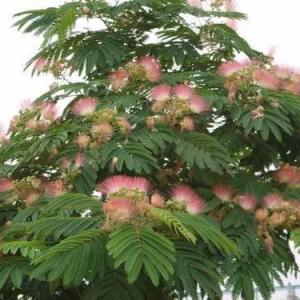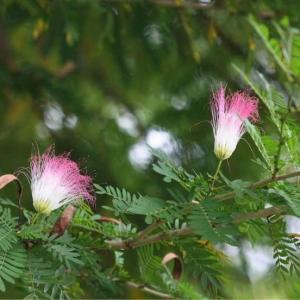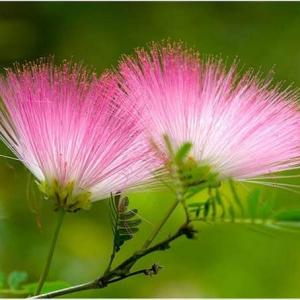文章
Miss Chen
2017年10月05日

La Acacia de Constantinopla es un árbol que pertenece a la familia Leguminosas, género Albizia, especie julibrissin.

Sus principales características son:
Altura: 8 a 10 metros.
Diámetro: 8 a 12 metros.
Crecimiento: mediano.
Suelo: bien drenado.
Temperatura: resiste medianamente el frío.
Transplante: tolerancia mediana.
Usos: ornamental y forestal.
Origen: Persia.

Es un árbol de porte mediano.
Su follaje, de color verde claro, es caduco. En el invierno adopta una silueta particular, ya que sus ramas sin hojas sólo presentan las vainas aplanadas que han dejado a su paso las flores. Estas aparecen como plumeritos de color rosado claro, muy perfumadas, a fines de la primavera.

Esta planta crece con rapidez y no es muy longeva. El interés de este árbol radica en su copa aparasolada, una característica que lo vuelve ideal para estacionamientos o sectores cercanos a las casas, y su sombra ligera.

Si bien su cultivo no presenta problemas, lo ideal es plantarlo a pleno sol y en suelos sueltos, bien drenados, aunque no sean muy ricos.
Se cultiva como especie ornamental y se reproduce por semillas.
Es importante tutorarlo desde joven, ya que su tronco tiende a curvarse. Por su forma y tamaño, resulta ideal para veredas y jardines pequeños.

Sus principales características son:
Altura: 8 a 10 metros.
Diámetro: 8 a 12 metros.
Crecimiento: mediano.
Suelo: bien drenado.
Temperatura: resiste medianamente el frío.
Transplante: tolerancia mediana.
Usos: ornamental y forestal.
Origen: Persia.

Es un árbol de porte mediano.
Su follaje, de color verde claro, es caduco. En el invierno adopta una silueta particular, ya que sus ramas sin hojas sólo presentan las vainas aplanadas que han dejado a su paso las flores. Estas aparecen como plumeritos de color rosado claro, muy perfumadas, a fines de la primavera.

Esta planta crece con rapidez y no es muy longeva. El interés de este árbol radica en su copa aparasolada, una característica que lo vuelve ideal para estacionamientos o sectores cercanos a las casas, y su sombra ligera.

Si bien su cultivo no presenta problemas, lo ideal es plantarlo a pleno sol y en suelos sueltos, bien drenados, aunque no sean muy ricos.
Se cultiva como especie ornamental y se reproduce por semillas.
Es importante tutorarlo desde joven, ya que su tronco tiende a curvarse. Por su forma y tamaño, resulta ideal para veredas y jardines pequeños.
0
0
文章
Dummer. ゛☀
2017年09月01日

Silk tree mimosa (Albizia julibrissin) growing can be a rewarding treat once the silky blooms and fringe-like foliage grace the landscape. So what is a silk tree? Keep reading to learn more.
What is a Silk Tree?
Mimosa trees are a member of the Fabaceae family and are a popular ornamental tree in the home landscape. Also known as silk trees and Albizia silk trees, these beauties have a lovely feathery habit with wispy pink to rose aromatic flowers. Ideal for USDA planting zones 6 through 9, this tree provides light shade and adds a lovely burst of color amongst other deciduous or evergreen trees, or when used as a specimen. The fringed foliage ranges from bright green to chocolate brown, depending on the variety.
How to Grow a Silk Tree
Silk tree mimosa growing is really quite easy. Albizia silk trees need a little space to accommodate their arching habit, so be sure to plan for this accordingly when planting. Roots like to spread out as well, so it is wise not to plant this tree close to a sidewalk or other cement patio where it could cause disruption. Some people also prefer to locate mimosa trees away from gathering areas because flower and pod shed can be kind of messy. Mature trees open into a lovely “V” shape and reach about 30 feet high. Mimosa thrives in full sun and is not picky about soil type. The tree is easy to start from a seed pod or a young tree. Anyone who has a mimosa would be happy to share seed pods with you.
Silk Tree Care
Silk trees need just enough water to keep moist; they will even tolerate a short period of drought. A 2-inch layer of mulch will help to protect the tree and keep the soil moist. If you are getting regular rainfall, it is not necessary to water your tree. Fertilize your tree with compost or organic fertilizer in early spring before the leaves appear. Prune dead branches to keep the tree healthy. Keep an eye out for webworms, which seem to be attracted to this tree. In some regions, canker is a problem. If your tree develops canker, it is necessary to remove infected branches.
Container Growing
Mimosa also makes an excellent container plant. Provide a large container with plenty of loamy soil and excellent drainage. Smaller chocolate mimosa trees make excellent container specimens. Throw in some trailing plants for a beautiful patio or deck display. Water when dry and trim dead branches as needed.

What is a Silk Tree?
Mimosa trees are a member of the Fabaceae family and are a popular ornamental tree in the home landscape. Also known as silk trees and Albizia silk trees, these beauties have a lovely feathery habit with wispy pink to rose aromatic flowers. Ideal for USDA planting zones 6 through 9, this tree provides light shade and adds a lovely burst of color amongst other deciduous or evergreen trees, or when used as a specimen. The fringed foliage ranges from bright green to chocolate brown, depending on the variety.

How to Grow a Silk Tree
Silk tree mimosa growing is really quite easy. Albizia silk trees need a little space to accommodate their arching habit, so be sure to plan for this accordingly when planting. Roots like to spread out as well, so it is wise not to plant this tree close to a sidewalk or other cement patio where it could cause disruption. Some people also prefer to locate mimosa trees away from gathering areas because flower and pod shed can be kind of messy. Mature trees open into a lovely “V” shape and reach about 30 feet high. Mimosa thrives in full sun and is not picky about soil type. The tree is easy to start from a seed pod or a young tree. Anyone who has a mimosa would be happy to share seed pods with you.

Silk Tree Care
Silk trees need just enough water to keep moist; they will even tolerate a short period of drought. A 2-inch layer of mulch will help to protect the tree and keep the soil moist. If you are getting regular rainfall, it is not necessary to water your tree. Fertilize your tree with compost or organic fertilizer in early spring before the leaves appear. Prune dead branches to keep the tree healthy. Keep an eye out for webworms, which seem to be attracted to this tree. In some regions, canker is a problem. If your tree develops canker, it is necessary to remove infected branches.

Container Growing
Mimosa also makes an excellent container plant. Provide a large container with plenty of loamy soil and excellent drainage. Smaller chocolate mimosa trees make excellent container specimens. Throw in some trailing plants for a beautiful patio or deck display. Water when dry and trim dead branches as needed.
0
0










